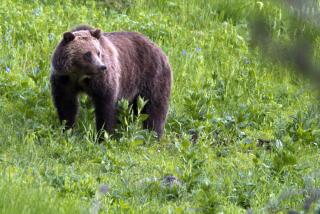Robert C. Stebbins dies at 98; Berkeley reptile, amphibian expert
If anyone could make lizards, salamanders, snakes and all measure of creepy, crawling things objects of wonder and even beauty, it was Robert C. Stebbins.
His well-regarded books, lectures and artwork made him a superstar among those who studied reptiles and amphibians, from world-famous scientists to weekend naturalists who hiked with his nature guides in hand.
Although he did much of his work alone and tended toward shyness, Stebbins’ scientific discoveries and willingness to stand up for his convictions have been celebrated by many, including bestselling author Richard Dawkins. And in political circles, Stebbins was known for being a passionate, persistent advocate for establishing ecological reserves in desert lands to ward off damage done by off-road vehicles.
But his biggest contribution to the field was probably his popular “Field Guide to Western Reptiles and Amphibians,” first published in 1966 and illustrated with his own drawings and paintings. It was a major force in changing the public’s view toward the creatures he so admired.
“Before that book, if people went out to look for snakes, it was so they could gather them up to sell to pet shops or just show off to their buddies,” said Sam Sweet, professor of evolutionary biology at UC Santa Barbara. “What Bob did was help make a transition to a similar situation as bird watching, where it became OK to just look at the animals and leave them alone.”
Stebbins, 98, died Sept. 23 at his home in Eugene, Ore. He had been in failing health for the last year, said Robert Sanders, spokesman at UC Berkeley, where Stebbins taught and did research for more than three decades. Sanders said that Stebbins’ wife of 72 years, Anna-rose, was at his side when he died.
Robert Stebbins was quoted in a 2006 journal published by the American Society of Ichthyologists and Herpetologists as saying his wife shared his love of nature and was a strong supporter of his work, tolerating years of “frogs, toads and salamanders in the refrigerator, and tortoises on the sun deck and in the living room.”
Robert Cyril Stebbins was born March 31, 1915, in Chico, Calif., near a small ranch and orchard that his family worked. On a camping trip in the Sierra foothills when he was 5, he had the first encounter he could remember with a reptile.
“Along a creek, I came upon a pond turtle,” he said in a 2005 Times interview. “I can still feel the sharp little claws in my hands and see its eye looking up at me, perhaps in fear. I was enthralled.”
When Robert was 9, the Stebbins family moved to Southern California — first to Pomona and later to Sherman Oaks. He graduated from North Hollywood High School in 1933 and went on to get his undergraduate degree and doctorate in zoology at UCLA.
While going to college he also spent time working as a park ranger, and during World War II UCLA obtained a waiver from combat duty so that he could teach Navy medical personnel how to prevent parasitic diseases.
He landed at UC Berkeley’s Museum of Vertebrate Zoology in 1945 as its first curator of herpetology — the study of reptiles and amphibians — and was involved in numerous studies. In 1949 he initiated one of the best known — it was on a pair of Ensatina salamanders that looked very different and apparently didn’t interbreed. But the “elegantly worked out” study, as Dawkins described it in his 2004 book “The Ancestor’s Tale,” showed that the salamanders had common ancestors but then developed different traits because of being separated for a long period by a geographical barrier.
Stebbins was beloved by students but spent much time toiling alone in his office on the drawings and paintings that were used in his field guides. Generally working from live, anesthetized animals, he measured every part to work out proportions. In contrast, Sweet, who met Stebbins in 1970 when he was a graduate student at the university, said, “What I would do was take a Xerox of the animal, blow it up and go from there. But Bob was absolutely meticulous.
“And when he was done, it was the animal. It was perfect.”
Stebbins’ books were published as part of the Peterson Field Guides series. “Before them, there had not been anything you could hold in your hands, with good illustrations and distribution maps. They were in bookstores and kids could get them for Christmas.
“They showed you could go out and do this yourself.”
Stebbins retired from the university in 1978 but continued to work on books. The “Field Guide” is now in its third edition, and his “Connecting With Nature,” published in 2012 by the National Science Teachers Assn., is a guide to getting students more interested in the natural world.
One of his main causes was to preserve sections of desert lands in California from use by dirt bikes, all-terrain vehicles and similar motorized vehicles. His efforts were met with strong objection from off-road vehicle enthusiasts, but in 1994 the federal California Desert Protection Act was passed, designating numerous wilderness areas in the state.
In addition to his wife, Stebbins is survived by son John of Eugene, Ore; daughters Melinda Broadhurst of Adelaide, Australia, and Mary Stebbins of Vernon, Canada; six grandchildren, 10 great-grandchildren and his sister Rosalie Darling of Yreka, Calif.
One of the most recent accolades he received came last month with the naming of a species of lizard, Anniella stebbinsi, in his honor.
More to Read
Start your day right
Sign up for Essential California for the L.A. Times biggest news, features and recommendations in your inbox six days a week.
You may occasionally receive promotional content from the Los Angeles Times.







